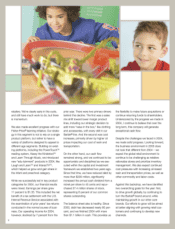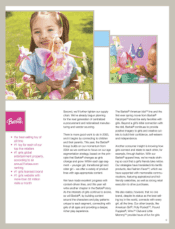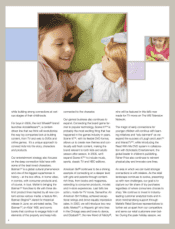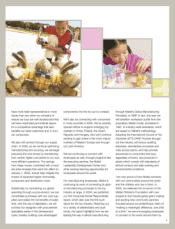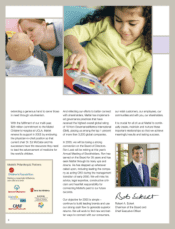Mattel 2004 Annual Report Download - page 14
Download and view the complete annual report
Please find page 14 of the 2004 Mattel annual report below. You can navigate through the pages in the report by either clicking on the pages listed below, or by using the keyword search tool below to find specific information within the annual report.PART I
Item 1. Business.
Mattel, Inc. (“Mattel”) designs, manufactures, and markets a broad variety of toy products worldwide
through sales to retailers and wholesalers (i.e., “customers”) and directly to consumers. Mattel’s vision is to
provide “the world’s premier toy brands—today and tomorrow.” Management has set six key company
strategies: (i) improve execution of the existing toy business; (ii) globalize the brands; (iii) extend the brands into
new areas; (iv) catch new trends, create new brands and enter new categories; (v) develop people; and
(vi) improve productivity, simplify processes and maintain customer service levels.
Mattel believes its products are among the most widely recognized toy products in the world. Mattel’s
portfolio of brands and products are grouped in the following categories:
Mattel Brands—including Barbie®fashion dolls and accessories (“Barbie®”), Polly Pocket!™and Disney
Classics (collectively “Other Girls Brands”), Hot Wheels®, Matchbox®and Tyco®R/C vehicles and
playsets (collectively “Wheels”) and Harry Potter™, Yu-Gi-Oh!™, Batman™, Justice League™, Megaman™
and games and puzzles (collectively “Entertainment”).
Fisher-Price Brands—including Fisher-Price®, Little People®, Rescue Heroes®, BabyGear™and
View-Master®(collectively “Core Fisher-Price®”), Sesame Street®, Barney™, Dora the Explorer™,
Winnie the Pooh, InteracTV™and See ’N Say®(collectively “Fisher-Price®Friends”) and Power Wheels®.
American Girl Brands—including American Girl Today®, The American Girls Collection®and
Bitty Baby®. American Girl Brands products are sold directly to consumers and its children’s publications
are also sold to certain retailers.
Mattel was incorporated in California in 1948 and reincorporated in Delaware in 1968. Its executive offices
are located at 333 Continental Blvd., El Segundo, California 90245-5012, telephone number (310) 252-2000.
Business Segments
“Mattel” refers to Mattel, Inc. and its subsidiaries as a whole, unless the context requires otherwise. This
narrative discussion applies to all segments except where otherwise stated. Mattel’s reportable segments are
separately managed business units and are divided on a geographic basis between domestic and international.
The Domestic segment is further divided into Mattel Brands US, Fisher-Price Brands US and American Girl
Brands. For additional information on Mattel’s business segment reporting, including revenues, segment income,
and assets, see Item 7 “Management’s Discussion and Analysis of Financial Condition and Results of
Operations—Results of Continuing Operations—Business Segment Results” and Item 8 “Financial Statements
and Supplementary Data—Note 11 to the Consolidated Financial Statements.” For additional information
regarding geographic areas, see Item 8 “Financial Statements and Supplementary Data—Note 11 to the
Consolidated Financial Statements.” For a discussion of the risks inherent in the foreign operations of Mattel,
which affect each segment, see Item 7 “Management’s Discussion and Analysis of Financial Condition and
Results of Operations—Factors That May Affect Future Results—Political Developments, including Trade
Relations, and the Threat or Occurrence of War or Terrorist Activities.”
Domestic Segment
The Domestic segment develops toys that it markets and sells through the Mattel Brands US, Fisher-Price
Brands US and American Girl Brands segments.
3




